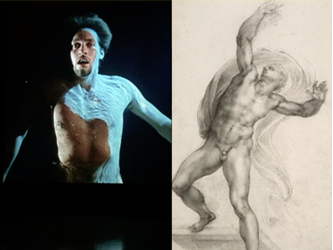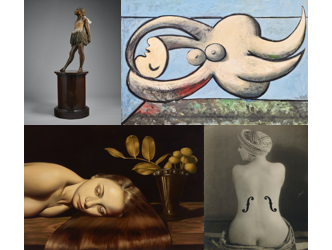Quiet in January
Usually in January the art market community is deemed to be quiet.
New York in May
This year it impatiently awaits the auctions that have received a lot of media coverage due to take place in May in New York, with works on sale by Rothko, Richter and Picasso from two prestigious New York collections, that of the recently deceased financier Don Marron and the couple Harry Maclowe (a real estate mogul) and his wife Linda, who are divorcing. The rumours, recently confirmed by Bloomberg, allege that these two collections together are forecast to be worth over a billion dollars.
Art Basel Hong Kong
On the other side of the world in Hong Kong, there are major concerns surrounding the large-scale Asian fair Art Basel Hong Kong, which is meant to be taking place in two months’ time. Up until now this free port on a city-wide scale was considered to be the new El Dorado of the art market, the advanced platform for transactions with all the large Chinese fortunes that pride themselves on art.
Violent clampdowns
The political movements on the island and the violent clampdowns they have brought about have evidently pushed certain artists to request that their work not to be shown, while some gallerists have withdrawn, and others have officially written to the organizers to ask for a substantial reduction in the costs of their participation.
The coronavirus
The risk of the spread of the coronavirus in this neighbour to mainland China exacerbates the situation even more and creates a risk – although it is very difficult to say what the local and global health situation will look like in March – of the event being cancelled, within a context of financial instability for Art Basel’s parent company, MCH, weakened by its watchmaking activity, Baselworld. The cancellation of the show for 2020 would lead to an earthquake in the sector, and a definite loss of confidence within the global art market.
Statement from Art Basel
A representative from Art Basel said on 30 January in a statement: “Art Basel and MCH leadership are taking the situation in Asia extremely seriously and we share many of the concerns expressed to us by our gallerists. At this time, we do not have an update to share. We recognize the urgency, and we are working hard to explore all possible options.”
Meanwhile in Paris
Meanwhile Paris, compared to the turmoil of Brexit in London and the political machinations in Washington, seems to have never been – in spite of the long strikes across the country in 2019 – so desirable in the eyes of art market operators. After the opening last October of a gallery in the Marais by David Zwirner and an office by White Cube, other art multinationals are seeking to open branches there. Hauser & Wirth and Levy-Gorvy are on the lookout for premises while the French gallery Kamel Mennour is also expanding to the left bank.
Brafa in Brussels
It is within this context that not far away, in Brussels, the Brafa fair is being held until 2 February with an offering of antiques but also of modern and contemporary art which – alas – continues to be too uneven.
Art Geneve

On the East side of the border, in Geneva, there is a modern and contemporary art fair running until 3 February which is beginning, in its ninth edition, to reach its cruising speed: Art Genève.
Microclimate of tranquility
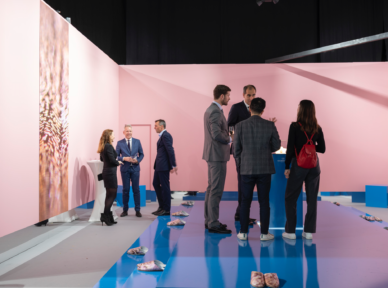
Miraculously it seems to exist within a microclimate of thriving tranquillity: “We are not unaware that the global context is difficult, but our region enjoys a certain solidity in the market,” explains the director of Art Genève, Thomas Hug, who adds: “Of course here we do not deal in the most spectacular purchases, nor the fastest. We present a show on a human scale, with 95 participants. The average amount for transactions here is between 20,000 and 80,000 euros. But we can believe that the results are satisfying since all the galleries from last year, including the big names like Gagosian or Kamel Mennour, have returned this year.”
Swiss collectors
The main target buyers are the Swiss French expanded to the Swiss German, as well as a few Parisian collectors.
Nuggets for connoisseurs
The defining feature of Art Genève is that it offers certain nuggets for connoisseurs of modern and contemporary art, far from the flashy and talked-about works that usually fill the art market columns.
Hauser&Wirth
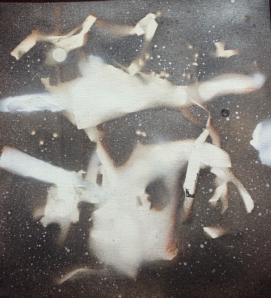
Hauser & Wirth are exhibiting a small spray paint work from 1959 (most likely one of the first of this genre) made by one of the giants of American abstract sculpture, David Smith (1906-1965), on sale for 325,000 dollars.
Levy-Gorvy

At the Levy-Gorvy gallery, also based in Zurich among others for a year in partnership with Andreas Rumbler, you would have to invest 900,000 dollars to obtain a mini painting by one of the greats of American abstraction, Frank Stella (born in 1936), from his most radical beginnings, since the striped black and white canvas dates from 1960.
Leopold Survage
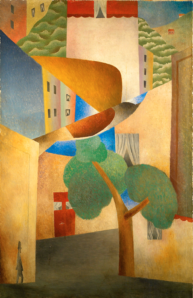
In a more classic vein there’s an unmissable cubist painting at the booth of the Parisian Le Minotaure gallery made up of successive planes suffused with a strange atmosphere, made by the Russian artist who was based in Paris at the time in Montparnasse, Leopold Survage (1879-1968). Never before seen on the market, it is on sale for 250,000 euros. His later oeuvre, which became blander over time, most likely explains his being lost to obscurity within art history. Survage still remains an important member of the avant-garde from the 1910s. For the history of modern art has, for some years now, been being fundamentally re-examined and certain names have benefitted, quite rightly, from a renewed interest.
Felix Vallotton
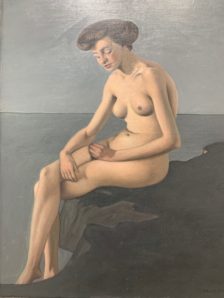
This is the case for the Swiss painter Felix Vallotton, whose canvas depicting a female nude which was very radical in its starkness, dating from 1908, is on sale for 180,000 euros with Larkin Erdmann from Zurich.
Auguste Renoir
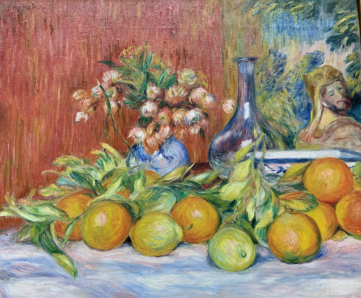
In contrast, if there is an artist whose value has plummeted, not always wrongly since he really did over-produce, particularly towards the end of his life, it is the impressionist Auguste Renoir (1841-1919). But at Art Genève, at the booth of the Bailly gallery we can see a counter-example: one of his excellent still lifes dating from 1888 defined by a landscape background and a historical figure, on sale for 3 million euros. One of the most expensive works at the fair.
Is small more beautiful?
Amid a certain upheaval in the behaviour of humankind towards our planet, now that the carbon footprint has become one of the benchmarks for contemporary environmental morality, is the future of the art market now at these local shows, more modest in size, far from the market’s large-scale displays of strength that developed at the end of the 20th century?
In any case, the most active and powerful galleries in the world are no longer reluctant to attend.
Until 2 February. https://artgeneve.ch/
Support independent news on art.
Your contribution : Make a monthly commitment to support JB Reports or a one off contribution as and when you feel like it. Choose the option that suits you best.
Need to cancel a recurring donation? Please go here.
The donation is considered to be a subscription for a fee set by the donor and for a duration also set by the donor.


